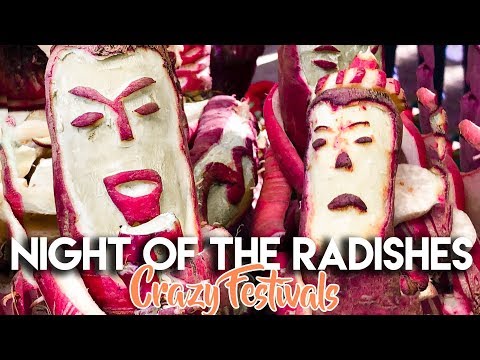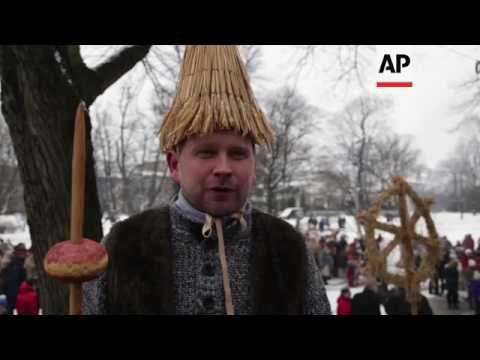Traditions vary greatly depending on the country. Here are ten practices that seem to bypass the typical gift-giving, eggnog, holiday dinner, and decorated tree and go for something much more unique.
10 Love Is Behind the Door in the Czech Republic
What if we met our soul mate during the holidays? They believe in it in the Czech Republic, and they put all their chances on their side owing to a bizarre custom. A single lady is expected to stand in front of a door and throw a shoe over her shoulder. If the shoe falls to the ground with its tip toward the door, the woman will marry during the following year.[1] Watch this video on YouTube Other “finding love” traditions also exist, including the Wigilia, the calebrated Christmas Eve dinner in Poland, where straw is placed under a tablecloth. When someone pulls a piece of straw from beneath the cloth, it signifies possible love: green means an upcoming marriage, and yellow indicates another year of being single. In Sweden, check your risgrynsgröt—a cinnamon-infused rice pudding—for the almond. If it’s in your dish, love is in your future. Variations of these and other love-finding traditions are celebrated throughout the world—even if just for fun!
9 Naked Family in Estonia
Families in Estonia are used to sharing a particularly relaxation period after the traditional Christmas supper. They are, indeed, all nude in a sauna. Pudiques, please refrain! Now, those Estonians have a sense of humor and have made a visit to the sauna at Christmas (Joulud) tradition—a blessing, actually—given that the average December temperature in Tallinn is around -5°C (23°F). Families would prepare their homes and decorate them for the holidays, and then, before trudging through the Northern European snow to the midnight church service, they’d go relax for a bit in the saunas and steam baths. What could be more festive than sitting with your family, nude and sweating, on a cold winter evening? But it’s not just the Estonians; the Finns also share in this celebration, as do other cultures with cold, freezing winters.[2]
8 Naughty Children Banned from the Netherlands
Every year, on December 5th, Sinterklaas visits youngsters in the Netherlands and offers them gifts. He is joined by his attendants known as the Zwarte Pieten for this distribution. They carry a list with the names of the mischievous youngsters who receive bits of coal instead of gifts. According to Dutch legend, Sinterklaas resides in Madrid, wears a crimson clerical gown and a bishop’s miter, and has slaves known as “Zwarte Pieten” (Black Peters). Despite the fact that Zwarte Pieten are black because they spend so much time in chimneys, many people in the modern Netherlands are concerned about them being too controversial. The Zwarte Pieten put the naughtier youngsters in luggage and transport them to their nation of birth…Spain! Retribution for the period when the Netherlands was under the rule of the Holy Roman Empire (between 1518 and 1714).[3]
7 A Monstrous Cat in Iceland
Yule, a pagan winter solstice celebration in Iceland, correlates to Christmas. At dusk, the Yule cat (also known as Jólakötturinn) prowls the land, ravenous. It is a frightening beast that both frightens and hunts men! But not any ordinary dude! The only people who need to be afraid of Yule cat are those who haven’t been able to find or make a new outfit for the celebration. Since the Middle Ages, this cat has been parsing out bizarre justice. In fact, the punishment was so terrifying that it was employed to intimidate employees into finishing their wool harvest faster as early as the 800s. As a result, the Yule Cat served as a motivation for the less fortunate to work hard in order to guarantee that everyone had something fresh and warm to wear for Christmas and so avoided being devoured by a terrible feline. Terrified youngsters would be on their best behavior, letting the grownups focus on their profession, or risk the horrifying repercussions of everyone being devoured by a giant cat. However, there are some practical implications to this story. It may reach as cold as minus 10°C (14°F) in Reykjavik during the winter, so it would appear that if the cat didn’t get you, the icy weather would.[4]
6 A Santa Claus Championship in Switzerland
The annual Sant Claus World Championship or ClauWau is held in the Swiss village of Samnaun! Teams costumed as Father Christmas from all around the world gather to engage in sports activities like ski races, snowshoe races, sled races, and gingerbread baking competitions…events that are unique and allow the victors to be recognized. This year, 20 Santa teams met in Samnaun, a village in the eastern Alps. They participated in a variety of categories, including the Santa downhill contest, Christmas present collection and transport, and geography-based gingerbread baking. They also competed in the talent of descending down a chimney, which is a must-have for any aspiring Santa. After everything was said and done, the title was won by the team “Teleschmutzlis” from the host country.[5]
5 A Radish Festival in Mexico
Every year on December 23, an art event called “Noche de Rabanos” is held in the Mexican state of Oaxaca. “Noche de los Rabanos” literally means “Night of the Radishes.” Mexicans showcase works of art fashioned from very large vegetables sliced into pieces and positioned to form sculptures during this event. The tournament attracts around 100 contestants each year. This is a long-standing practice that dates back to the 16th century and is associated with the country’s colonial history. The competition’s beginnings may be traced back to when holiday market merchants attempted to make their veggies more appealing by sculpting them. It was so popular that the governor, Francisco Vasconcelos, decided to hold an official competition in 1897. Since then, it has become a tradition in Oaxaca. The festival begins in the morning when everyone can watch the artists at work on their sculptures, but you must wait until the evening to view the final marvels. The celebration also includes music across the city, pyrotechnics, and light displays.[6]
4 Spiders in Ukraine
You’ve surely heard of the German pickle legends, in which grownups place a pickle in a Christmas tree, and the first child to locate it receives a bonus present. If you thought it was unusual and culturally distinct, you should know that Ukrainians decorate their Christmas trees with spider webs. You may be asking why Ukrainians would do such a thing. Spiders and their webs are considered lucky among Ukrainians. So, instead of garlands, balls, and stars, they chose spider webs to decorate their Christmas tree…A wish for wealth and good fortune in the following year. The practice harkens back to long-forgotten Ukrainian Christmas folklore. This is how one version of the folklore goes. Because a poor widow had no money to decorate the tree, spiders utilized her children’s tears to construct lovely webs to decorate the tree during the night. The family’s fortunes improved the next day, and they lived in opulence.[7]
3 Elves on the Move in the USA
Created by a mother and her two daughters from a family tradition, Elf on a Shelf is not one steeped in years of ritual like many on this list. First begun in Georgia, the practice soon gained popularity around the U.S. With the Elf on a Shelf book and “Scout Elf,” parents can be assured that their children will behave. If they don’t, the elf will notify Santa when he returns to the North Pole every night to give his report. The supposed magic comes when the Elf on a Shelf returns and waits in a different place every day, just watching to catch the little kiddos doing something naughty. With more than 15 million “Scout Elves” on the job, they have become quite creative in their hiding places. Tons of stories and videos show the charming, funny, and frightening places—sometimes in inappropriate positions and places too—that the Elf on a Shelf likes to wait.[8]
2 Halloween at Christmastime in Latvia
One Christmas tradition is more like Halloween in Latvia, as it is in Ukraine. They begin preparing for Christmas soon after the Night of the Candles, a remembrance ceremony. This is the season for Kekatas, a traditional mask procession, when Latvians dress up in masks and go door-to-door singing, dancing, and playing games. It is said that the homes the “Masque Procession” visits will be blessed with good luck. In appreciation, the masked visitors are often treated to food and small presents. The masks are to ensure the participants are not recognized. They can be maks of animals, people, or mythological creatures. In addition to bringing luck, the masked well-wishers are tasked with scaring away evil spirits.[9]
1 Excrement in Spain
Tió de Nadal is one of Catalonia’s most strange and hilarious Christmas customs. Caga Tió is the Catalan version of Santa Claus, wearing a typical Catalan red cap. Children in Spain, particularly in Catalonia, become delighted about “Caga Tió,” which translates as “pooping log.” In reality, Caga Tió is a traditional Christmas treat! It’s a small wooden log with a smiling face painted on one end that “evicts” gifts! In early December, the log is put near the fire and covered with a blanket. Every night, the youngsters feed it chocolates and nuts in the hopes that it will grow larger and larger. Then on Christmas, when the log is all fattened up, it will “reveal” its gifts; essentially the more you feed it, the more gifts it poops. Traditionally, these gifts are nougats, sweets, little toys, and money. Youngsters are expected to look after Caga Tió every day. The children are also expected to be on their best behavior, or Caga Tió will not produce any presents. Every day until Christmas, the children give him goodies. Watering him, providing tiny pieces of candy, and even keeping him covered with a blanket to keep out the chill are all part of the tradition. When it’s time for presents, the children sing a special song and hit the pooping log with sticks to encourage it to “poo.”[10]























